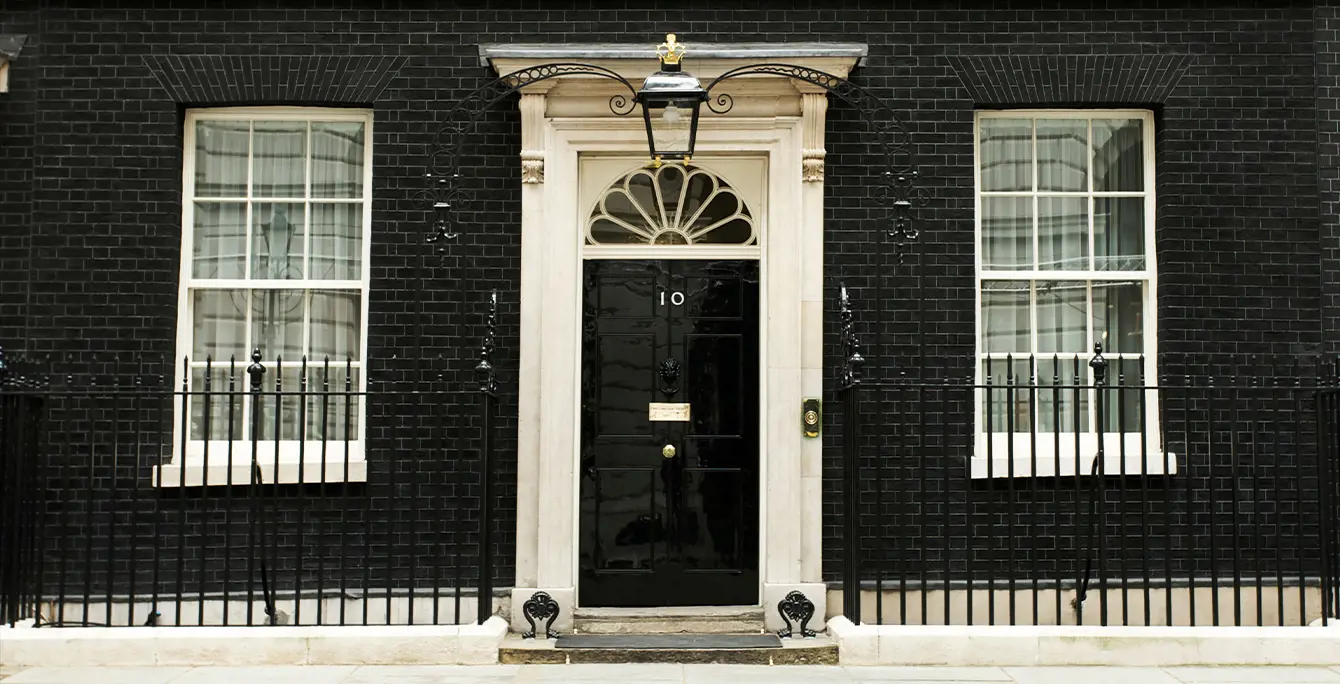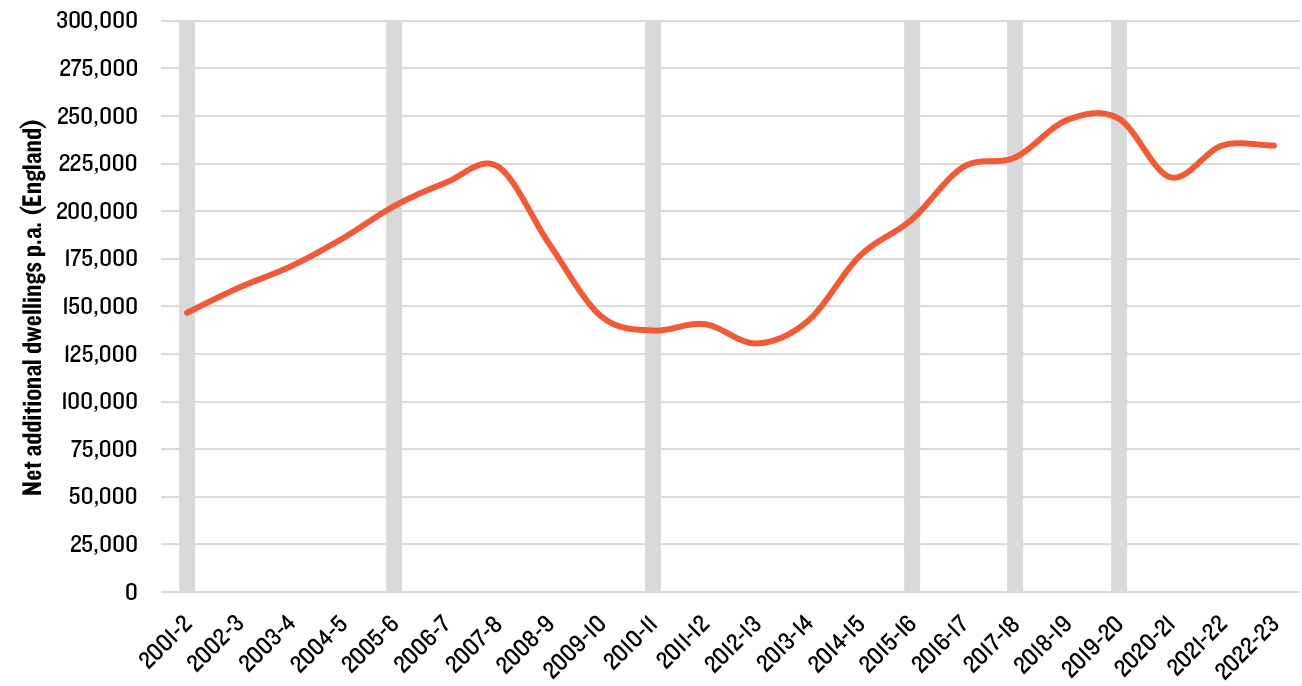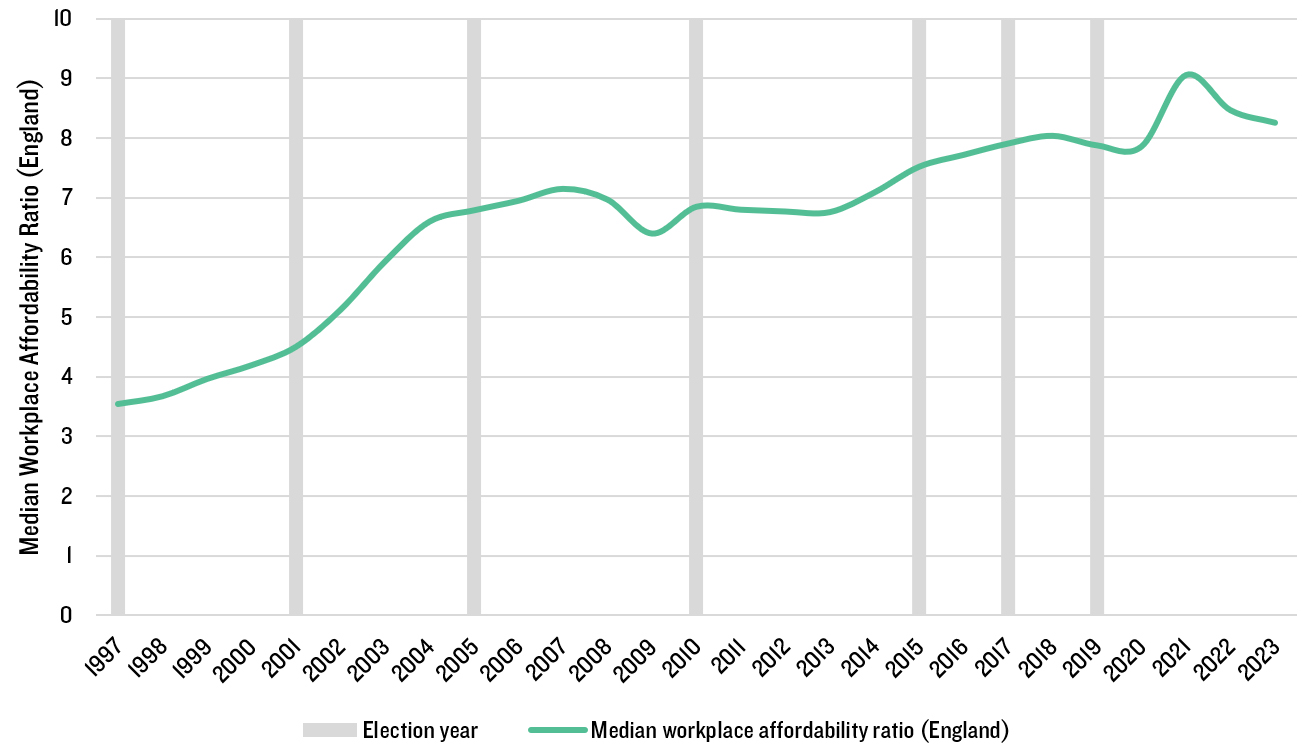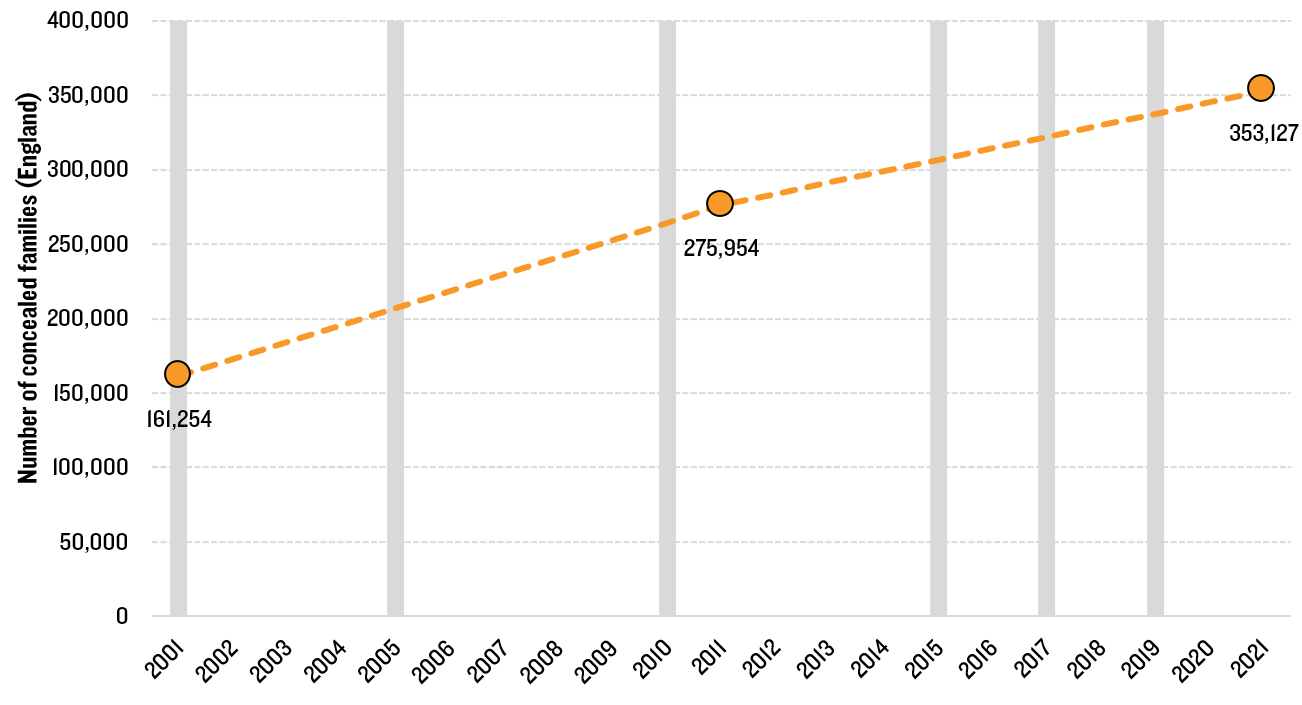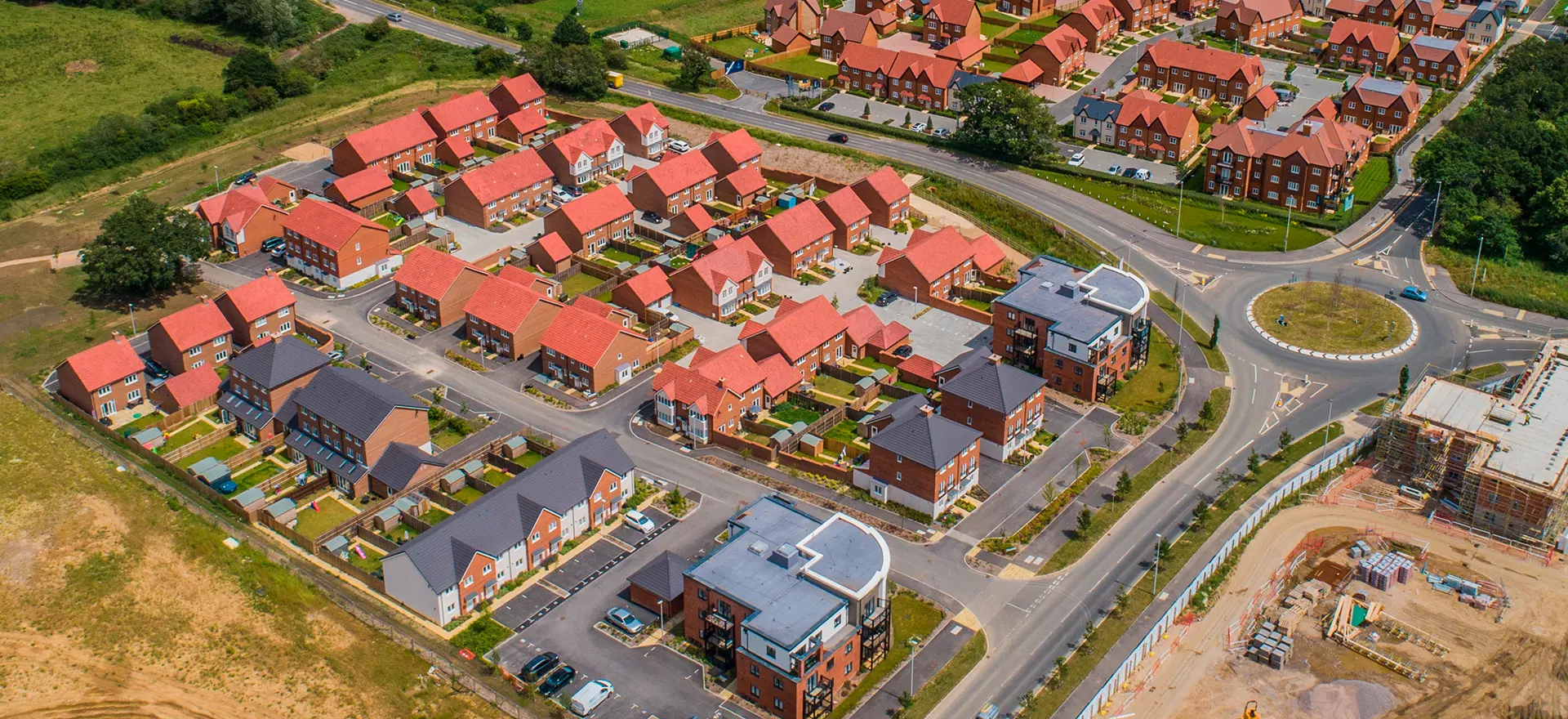An updated NPPF was published in December 2023
[1], including within a number of changes to policy for how local planning authorities (LPAs) set their housing requirements within Local Plans. This followed consultation on a set of proposed changes
[2] announced in December 2022 which were regarded by many – not least those outside Government who supported the changes - as being likely to reduce the level of new housing supply. Key elements of the proposed policy were removing the requirement for Green Belt review and weakening provisions for neighbouring areas to take on unmet need.
In February 2023, Lichfields produced
analysis for the Home Builders Federation (HBF) and Land and Planning Federation (LPDF) that estimated the impact of the potential changes on the number of homes that would be planned for by 2030, concluding that it might lead to a fall in supply (compared to recent rates of delivery) of 77,000- homes per annum, to just 156,000, well short of the 300,000 national ambition. This factored in the ongoing difficulties being faced by London in meeting its need (under-delivering against it's London Plan target which in turn was less than its need).
At the Levelling Up, Housing and Communities select committee in April that year
[3], the then planning Minister, Rachel Maclean MP was asked about the risk of the changes leading to a fall in housebuilding, with Andrew Lewer MP (a member of the committee) suggesting the proposal would mean a “
gargantuan Titanic iceberg sized hole” in the Government’s ambition to boost housebuilding. The Minister responded that
“We’re very clear that we want to see those numbers of houses built […] and the way that we will achieve that is by having local plans and making it quicker, easier, simpler, clearer for local authorities to get the local plans in place.”
The Department’s analysis of the NPPF proposals
[4] says that:
“On average, authorities without an up-to-date Local Plan would have 14% higher housing supply if their housing supply (as a proportion of existing housing stock) were as much as those with an up-to-date plan. Care should be taken about assuming an entirely causal relationship as there are likely to be unobserved factors associated with having an up-to-date local plan, such as how well-resourced a planning department the authority has and whether it has a favourable attitude towards supply. But overall, the analysis points to the possibility of increased Local Plan coverage helping deliver more homes.”
So, the Government’s argument is that if the NPPF changes lead to more local plans being produced, this will boost housing supply compared to what would be achieved without these plans.
Housing targets in local plans are an important factor in determining the number of homes that are built each year
[5] and achieving the 300,000 national ambition relies upon housing targets in Local Plans aggregating to something around that number. This is because local plan targets are used to determine the amount of land that is allocated and/or permissioned. They help LPAs with judgements over how the impacts and benefits of development are balanced, how large developments should be, how many should be provided and where, what infrastructure is needed to support them, and if they warrant public sector investment. Without targets, experience tells us that many Local Planning Authorities who are, at best, ambivalent about housing delivery, will simply stop new homes being provided.
The stalling of local plans became something of a trend in 2022 – 2023
[6] as LPAs responded to the prospect of changes in national policy, particularly the abolition or softening of housing targets.
However, as the Government’s intentions crystallised, a number of LPAs began to make demonstrable progress on their plans, with a small flurry of Regulation 18 or 19 draft blueprints produced for consultation over the past six months. What – if anything – do these emerging plans say about the approach being adopted by LPAs on housing targets in light of the Government’s new policy?
We have identified 25 Draft Local Plans (Reg 18 or 19) outside London
[7] that have been produced in the past six months and include a proposed housing requirement figure. Of these 25, 15 had previously produced an earlier Reg 18 Local Plan with a specific requirement figure proposed or preferred
[8]. These 25 have a combined Standard Method local housing need figure of around 25,000 per year, represent 12% of total national local housing need outside London (206,566).
Table 1 below shows what these 15 LPAs are proposing in terms of housing targets, and how these compare to net housing additions over the past three years, the Standard Method for local housing need, and the housing target that was proposed in its previous draft Reg 18 Local Plan.
The standard method housing need figures used in our analysis are based on the latest demographic and affordability data; these figures may therefore be different for the Standard Method figures used by the LPAs at the time they prepared their draft plans.
Table 1 – Summary of Local Plans with targets in earlier draft Reg 18 Plans.
Source: Lichfields Analysis
Notes:
[i] Oxford City Council – The earlier draft local plan annual requirement is based on policy H1 option a as it is clear option b to meet identified need is not practically possible;
[ii] Three Rivers – The June 2021 consultation does not set out a definitive proposed housing requirement for the plan, but sought to make provision for around 550 homes per annum over the plan period;
[iii] Dacorum – It is not clear what the housing requirement is in the local plan consultation document, but the link to the Sustainability Appraisal establishes the housing requirement under scenario 4;
[iv] East Hampshire – The local plan annual requirements relate to East Hampshire district, including the South Downs National Park; and
[v] Chelmsford – The earlier draft local plan annual requirement included a buffer which was removed in the proposed annual requirement.
The analysis reveals that:
- Of these 15, six have cut their housing targets by more than 100 homes per year. None are proposing a material increase on their previous emerging targets.
- The big reductions compared to earlier draft plans are: South Staffordshire -170 per annum; Three Rivers -280 pa; Horsham -223 pa; Hertsmere -170 pa; Canterbury -103 pa; Chelmsford -200 pa. All but one did so with the benefit of seeing the final December 2023 NPPF.
- In total, these 15 plans are proposing c.11,400 homes a year, compared to c.12,700 a year previously; a reduction of 10%.
- The housing need in these 15 Local Authorities equates to 13,630 homes per year, so these plans are undershooting the Government’s measure of housing need by 16%. Six of the 15 Local Plans are proposing not to meet their Standard Method local housing need figure. Only one, Chelmsford, is proposing to exceed its LHN by >50 per annum.
- Bristol – which is one of the 20 largest cities with the 35% urban uplift to its Standard Method – is planning to maintain its previous proposed target, but will undershoot its housing need by 1,450 homes per annum. The new NPPF says the urban uplift share of this unmet need will not be expected to be met in neighbouring areas[9] and in any event the surrounding districts are dominated by Green Belt which in the NPPF update is not required to be reviewed when preparing a plan[10].
- Over the total plan periods (which vary but are a minimum of 15 years), the 15 Local Plans will be undershooting their housing needs by 40,000 homes (total housing targets over plan periods of 245,233 against total housing need of 205,223).
- The Local Plans are in aggregate proposing more homes than were built on average in the past three years, although some (South Staffordshire, West Suffolk and Test Valley) would be doing less.
- Some of the reductions in housing delivery are perhaps explained by a perceived shift in Green Belt policy: Three Rivers, South Staffs, Hertsmere. In others (e.g. Chelmsford, Canterbury, Horsham), Councils have elected to do only what is required to meet their own minimum housing need figure and are choosing not to pursue extra growth or cover off unmet housing need from their neighbouring areas.
For the other ten Local Plans, where there is no single proposed local housing requirement figure in an earlier draft Local Plan, the analysis is set out in Table 2 below.
Table 2- Summary of Local Plans without targets in earlier draft Local Plan.
Source: Lichfields Analysis
Notes:
[i] Wolverhampton – The local plan annual requirement is based on the preferred option H3;
[ii] South Oxfordshire/ Vale of White Horse – The local plan annual requirement is based on the preferred option using the standard method, with an increase to allow for existing agreed unmet need from Oxford City;
[iii] Lewes – The local plan annual requirement is the mid-point of the range considered for the housing requirement of 271dpa to 468dpa; and
[iv] Thurrock – The local plan annual requirement is based on The South Essex Housing Needs Assessment (June 2022) as stated in the consultation document.
This set of 10 plans draws out some interesting dynamics in current plan making:
- Wolverhampton is one of the 20 urban centre uplift LPAs where the standard method housing need is increased by 35%. Like Bristol, it plans to undershoot its need, by 581 homes, and there is no expectation this uplift will be met in neighbouring areas. A challenge for the new West Midlands Mayor, perhaps, who might take a different stance to his predecessor, particularly on Green Belt.
- South Oxfordshire/Vale of White Horse has an emerging proposed target of 1,572, exceeding its Standard Method figure by 360 homes. However, neighbouring Oxford City has unmet need, and – more significantly - the previous (now abandoned) Growth Deal (in 2014) made by the Oxfordshire authorities and the government, had local plans for the combined area of just under 1,950 per annum[11] (based on the housing need associated with economic growth and delivery of infrastructure funding) so the emerging proposals represent a reduction on previous plans.
- Bournmouth, Christchurch and Poole – who are under-shooting their local housing need - make some criticisms of the Standard Method and suggest their own assessment (based on lower migration) is closer to their proposed target, but fundamentally cite constraints, including an untouched Green Belt as a reason for not hitting the standard method local housing need figure.
- Lewes – which is envisaging not meeting its standard method figure – is constrained by the South Downs National Park in the south of its district. It has identified some additional sites, and looked at options for growth in other parts of the district, but having considered the options claims it does not have sufficient land capacity. Time will tell whether that is a defensible position.
- Of the other plan areas, few are proposing materially more housing than the standard method, with only Arun in excess by >50 homes per annum.
When considering these 10 plans in combination with the 15 plans already considered above, the key findings are:
- In total, these 25 plans are proposing just under 20,900 homes a year.
- The housing need in these 25 Local Authorities equates to around 25,000 homes per year, so these plans are undershooting the Government’s measure of housing need by 17%. 10 of the 25 Local Plans are proposing not to meet their Standard Method local housing need figure. Only four are proposing to exceed their LHN by >50 per annum.
- In general terms, this direction of travel (areas with Green Belt not releasing enough land for housing, the 20 big cities with the urban uplift not meeting their 35% extra need, surrounding areas not picking up the slack) tends to support the thesis we predicted in the February 2023 analysis for the HBF/LPDF.
- Of course, it might be said these initial figures nevertheless support Rachael Maclean’s argument at the select committee: that, in encouraging these 25 plans to be produced, it will boost housing delivery compared to low recent housing delivery in these areas (the emerging targets across all 25 plans are some 19% higher than what has been achieved in recent years[12]). But then of course we know that the baseline is often no development being proposed at all, that at least 11 of these areas were already advancing plans proposing more than they do now, and it does not follow that the combined increase on recent build rates will be sufficient to meet the national goal.
It is too early to say what these emerging plans will do for actual housing delivery. For one thing, none have yet been examined or adopted. A number will not in fact benefit from the perceived protections of the new NPPF, being subject to the transitional provisions
[13] so might find themselves having to increase their housing requirements. Further, any change in the approach between previous draft plans and what is now proposed may not be directly related to changes introduced by the NPPF in December. A factor weighing on housing delivery is what happens
after the plan, with the removal of requirements to demonstrate a rolling five-year land supply in the event the plan’s trajectory proves inadequate
[14].
However, we can say that if these plans progressed on this basis, and the pattern was replicated across the rest of the country
[15], with local areas tending to undershoot or only do the minimum, with the 20 largest urban centres seemingly not on track to achieving their 35% urban uplift, and with unmet need going largely unaddressed, it would put 300,000 homes per annum firmly out of reach.
Blog updated on 20th May 2024.
[1] The NPPF can be found here
[2] The draft NPPF with indicative changes for consultation can be accessed here
[3] The transcript of the evidence session is here
[4] Within the Impact Assessment for the LURA available here
[5] For an analysis of the role of housing targets – see this blog here (written at the time when the short-lived Truss government pondered the removal of housing targets.
[6] See our blog on local plan delays here
[7] We have excluded London LPAs from our analysis because housing targets are set by the London Plan
[8] This excluded Reg 18 Local Plans with options for housing requirements presented for consultation, where no figure is identified as ‘preferred’ except where the proposed annual requirement is even lower than all the options considered in the earlier draft local plan for annual requirement figures, as is the case in Horsham
[9] NPPF para 62 says: “This uplift should be accommodated within those cities and urban centres themselves except where there are voluntary cross boundary redistribution agreements in place”
[10] NPPF para 147 says: “Once established, there is no requirement for Green Belt boundaries to be reviewed or changed when plans are being prepared or updated”
[11] Based on the Local Plan target for VoWH (819 per annum, including an allowance for Oxford’s unmet need) and South Oxfordshire Local Plan phased target of 1120 per annum for 2026-2032 and 1,110 from 2032-35 (see the joint housing delivery strategy here)
[12] 17,418 net additional homes were built in the 25 LPAs in the past three years compared to the emerging target of just under 20,900
[13] The new Framework (published on 19 December 2023) will only apply for the purpose of examining plans, where those plans reach regulation 19 of the Town and Country Planning (Local Planning) (England) Regulations 2012 (pre-submission) stage after 19 March 2024
[14] The evidence suggests optimism bias is prevalent in five-year land supply calculations and that, without the requirement to demonstrate a rolling five year land supply and the corrective mechanism available via NPPF para 11(d), it is possible actual delivery will undershoot targets by 20% - see here
[15] As the 25 plans considered represent 12% of total national local housing need outside London (206,566). London itself is planning to undershoot its housing need by some 46% and is delivering even less – see here.




